Understanding a large codebase is challenging, especially for new engineers. Traditional documentation often requires deep product and implementation knowledge, making onboarding slow and frustrating. AI-powered tools now offer automated solutions that generate documentation directly from source code, aiming to bridge this gap.
This article will compare two leading AI documentation engines, DeepWiki, and Code2Tutorial.
|
DeepWiki |
Code2Tutorial |
|
DeepWiki initial screen |
Code2Tutorial initial screen |
Both tools are blackbox tools designed to generate structured documentation from a repository URL, focusing on enhancing codebase comprehension and streamlining onboarding. Unlike general-purpose AI assistants, these specialized tools provide targeted, context-aware insights for engineers.
Our evaluation uses open source projects to assess each tool’s usability, depth, organization, and ability to explain both business logic and technical details. The goal is to highlight how these tools support newcomers and help teams choose the right solution for their documentation needs.
TL;DR
At the end of the article, we provide our in-depth analysis of each of our test results. But if you’re just looking to know what to use, here’s what you need to know: Both DeepWiki and Code2Tutorial significantly reduce the manual effort of writing documentation and make large codebases easier to approach. Still, their strengths and weaknesses lie in different areas:
-
DeepWiki delivers highly structured, detailed documentation with code-linked references and visualizations. This makes it especially valuable for experienced engineers who need architectural clarity or want to understand how and why a system was designed. However, it isn’t open source, and the sheer volume of information in its generated documentation can be overwhelming for newcomers.
-
Code2Tutorial shines in accessibility. Its casual tone, metaphors, and abundant code examples make it better suited for onboarding new developers. Its open source model is flexible, but technical hiccups, missing setup steps, and incomplete coverage limit its reliability.
A key takeaway from testing across projects is that the clarity of the generated documentation often reflects the quality of the codebase itself. Strong typing and well-structured codebases led to more accurate, digestible docs in both tools.
In short:
- Choose DeepWiki if your team needs deep dives, architectural insights, and a consistent structure.
- Choose Code2Tutorial if your priority is fast onboarding and practical, example-driven learning, though it does not provide setup steps.
Human review remains essential, but these tools already represent a big step forward in bridging the gap between code and comprehension.
➡️ Ready to train your developers to master tools like these? Explore Bitovi’s AI Training for Software Developers to upskill your team and adopt AI in ways that work for your business.
DeepWiki vs Code2Tutorial: Analysis
So, how did we arrive at these conclusions? To evaluate DeepWiki and Code2Tutorial's strengths and weaknesses, we tested them on three open source projects: jira-timeline-report, eggstractor, and bitballs.
For each project, we looked at (to learn more about our criteria, check here):
-
Accuracy – Does the documentation faithfully describe the code?
-
Organization & Structure – Is the material well-structured and easy to follow?
-
Depth of Explanation – Does it go beyond APIs to explain business logic and implementation details?
-
Digestibility – Is the content approachable for its intended audience?
-
Formatting Consistency – Are visuals, charts, and styles coherent across the document?
The sections that follow summarize our observations for each project, highlighting where each tool excelled, where it fell short, and what that reveals about its overall usefulness.
Jira Timeline Report

First, we are checking jira-timeline-report, which is an open source Jira to PowerPoint slide generator for high-level status reporting. The generated documentation can be found here: DeepWiki, Code2Tutorial.
|
Metric |
DeepWiki |
Code2Tutorial |
|---|---|---|
|
Accuracy |
4 |
3.5 |
|
Organization & Structure |
5 |
5 |
|
Depth of Explanation |
4 |
4 |
|
Digestibility |
3 |
4 |
|
Formatting Consistency |
4 |
4 |
- This codebase is rather difficult for a developer to understand. It includes a mid-refactor from 2 frontend frameworks: CanJS and ReactJS. CanJS also bootstraps various components, including React components. It relies heavily on URL query parameters for state management.
- Code2tutorial made some wrong assumptions about why there are ReactJS and CanJS frontend frameworks [1]:
For more complex or newer reports, we use React.
- DeepWiki omitted important parts in some areas (maybe for simplicity), making the sections incomplete, misleading, or uncurated.
- The project has a complex routing system. Neither tool could adequately capture why the routing was built the way it was.
Eggstractor
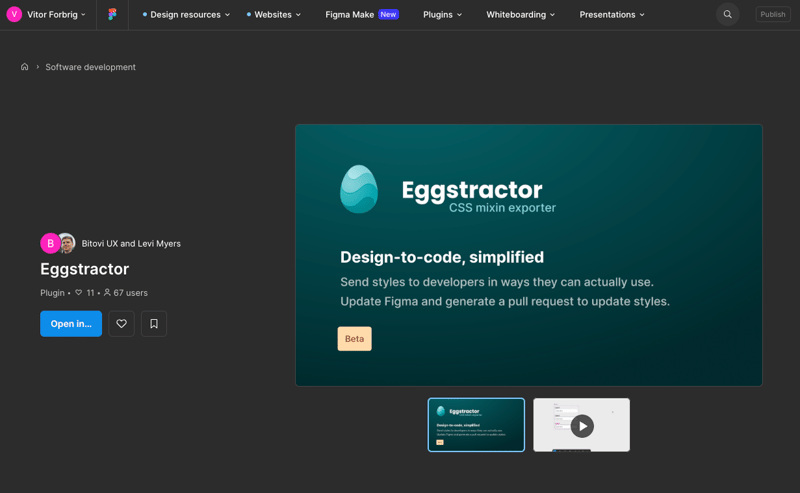
Next, we are checking eggstractor, a Figma plugin that lets you extract styles to mixins for various CSS frameworks. The generated documentation can be found here: DeepWiki, Code2Tutorial.
|
Metric |
DeepWiki |
Code2Tutorial |
|---|---|---|
|
Accuracy |
4.5 |
4.5 |
|
Organization & Structure |
5 |
4 |
|
Depth of Explanation |
5 |
5 |
|
Digestibility |
5 |
3 |
|
Formatting Consistency |
4 (chart label issues) |
3 |
-
-
Code2Tutorial had broken charts [1]:

-
- Both tools generated a misleading "Variant Processing" on DeepWiki / “Variant Style Optimization” on Code2Tutorial. While not necessarily wrong, the intent is that the end result will help the developer optimize his development lifecycle on his own project, and not that it is an optimization of eggstractor.
- I had a feeling that both the generated documentation is correct, but the tools would generate better documentation if they improved the codebase clarity.
- Code2Tutorial exemplification felt dense.
- DeepWiki has a bug in the chart labels when the chart is not open.
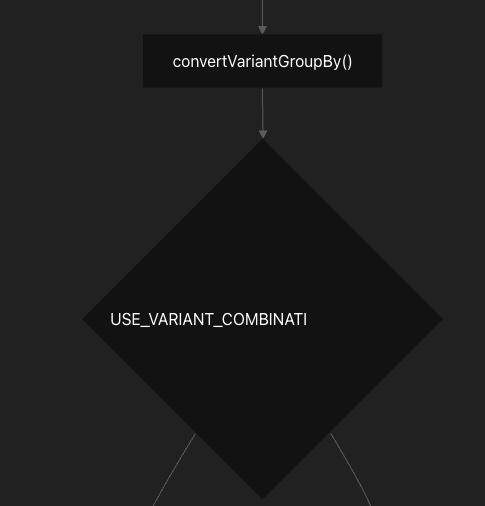
BitBalls

BitBalls is a charity basketball tournament management application. It is an example of an application done with donejs. The generated documentation can be found here: DeepWiki, Code2Tutorial.
|
Metric |
DeepWiki |
Code2Tutorial |
|---|---|---|
|
Accuracy |
4.5 (minor nitpicks) |
3.5 (missing content) |
|
Organization & Structure |
5 |
4 |
|
Depth of Explanation |
5 |
3 |
|
Digestibility |
5 |
4 |
|
Formatting Consistency |
4 |
4 |
- DeepWiki generated the same diagram for entity relations on the frontend and backend sections.
- It focuses on how it works, but it doesn’t explain the “why” of the implementation.
- Code2tutorial missed important complex details, such as the integration of the YouTube player.
📌 Interested in applying lessons like these to your own codebase? Explore Bitovi’s AI Training for Software Developers to upskill your team and adopt AI in ways that work for your business.
Overall AI-Generated Document Engine Comparison
DeepWiki and Code2Tutorial produce documentation in very different styles, and which one is “better” ultimately comes down to preference. When the generated documentation was unclear, the issue often traced back to ambiguity in the codebase itself rather than the AI. This suggests the clarity and accuracy of the output depend heavily on the strength of the underlying code, as we saw with jira-timeline-report.
Considerations for DeepWiki
What are the strengths of DeepWiki?
- DeepWiki provides highly structured, well-organized documentation that is especially useful for complex codebases.
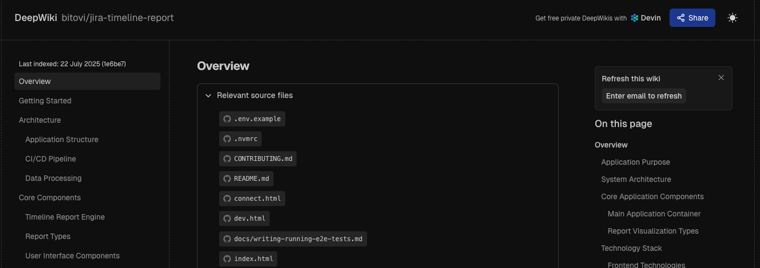
- Each page includes direct links to source files and functions, making it easy to trace explanations back to the code.

- It often includes setup steps and features an embedded AI assistant (Devin), though Devin reasons only over the codebase and not the generated documentation.

What are the limitations of DeepWiki?
DeepWiki’s detail can be a double-edged sword.
- The documentation is often dense and overwhelming for newcomers who need only a high-level overview.
- Because it is proprietary software, it offers less flexibility for teams looking for open or customizable solutions.
- Its focus on describing what the code does means it sometimes provides weak context on the “why” behind design choices, leaving strong technical explanations but limited rationale.
- AI chat Devin has limited utility, as it does not reference the generated documentation for its reasoning, only the codebase.
DeepWiki: TL;DR
Compared with Code2Tutorial, DeepWiki generates more charts and visualizations, helping teams understand relationships and architectural decisions. Its content is detailed and statement-focused, explaining exactly what different sections of the project do. This level of detail is most valuable for experienced engineers who need architectural clarity and insight into how systems were designed.
Considerations for Code2Tutorial
What are the strengths of Code2Tutorial?
- Code2Tutorial provides approachable, easy-to-read documentation that is well-suited for onboarding new developers, using metaphors to make technical concepts more relatable and easier to understand. Check out how it uses a nightclub bouncer to explain authorization:
|
Imagine our Bitballs application is like a sports club. Authentication is like showing your membership card at the entrance. It verifies who you are (Are you a club member? What's your name?). You provide your email and a secret password, and the system checks if you're a recognized member. Authorization is like checking your membership level once you're inside. Are you a regular member who can use the basic facilities? Or are you a club manager who can also access the private offices and change club rules? It determines what you are allowed to do after your identity has been verified. |
- C2T uses embedded code examples with added context to make documentation easy to read and understand.
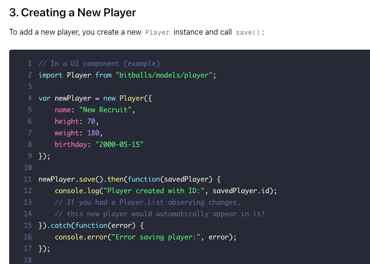
- The documentation is generated in markdown files, giving teams an open source, flexible format that can be customized or integrated into existing workflows.
What are the limitations of Code2Tutorial?
- Reliability is a recurring issue — the tool often produces errors such as “connection lost” or charts that fail to load without refreshing.
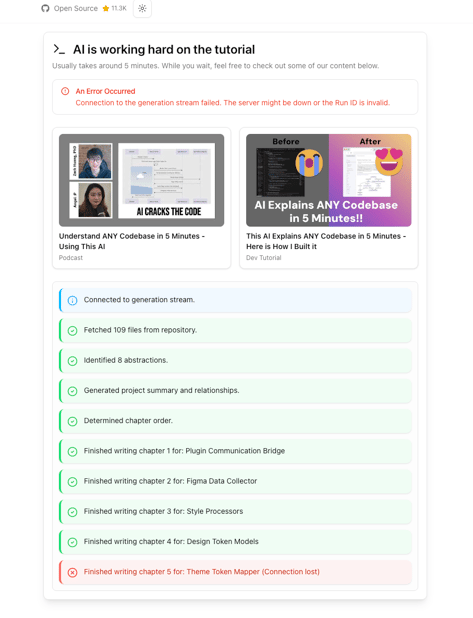
-
It does not include setup steps, leaving newcomers without clear guidance on how to run the project locally.
-
Code references are frequently plain text within sections rather than direct links, making it harder to trace explanations back to specific files.

-
By default, not all files are included in the generated documentation, requiring manual selection to achieve full coverage.
Code2Tutorial: TL;DR
Code2Tutorial excels at accessibility and onboarding, offering an approachable tone and practical examples that help new hires ramp up quickly. However, its reliability issues, lack of setup steps, and limited linking reduce its usefulness for teams that need complete, production-ready documentation.
Conclusion
AI-powered documentation tools like DeepWiki and Code2Tutorial are transforming how engineers approach onboarding and codebase comprehension, especially for projects lacking thorough documentation. DeepWiki excels in structured organization, integrated code references, and interactive features, making it ideal for experienced developers who need detailed architectural insights. Its proprietary nature and information-rich output may be overwhelming for newcomers, but invaluable for in-depth understanding.
Code2Tutorial, in contrast, offers a more approachable, casual tone and abundant code examples, making it well-suited for onboarding new developers. Its open source model provides flexibility, though users may encounter technical hiccups and must ensure all relevant files are included for comprehensive coverage.
Ultimately, the best choice depends on your team’s needs: DeepWiki is optimal for deep dives and architectural clarity, while Code2Tutorial shines for practical learning and accessibility. Both tools significantly reduce the manual effort of documentation, but human oversight remains crucial to ensure accuracy and relevance. As these tools evolve, leveraging their strengths alongside thoughtful review will deliver the most value to engineering teams.
Next Steps: Bitovi AI Training for Software Developers
-
🚀 Accelerate onboarding: Learn how to combine AI-powered documentation tools with proven practices to ramp up developers faster.
-
🧠 Upskill your team: Train engineers to use AI effectively for documentation, automation, and workflow improvements.
-
🔧 Integrate AI into your workflow: Work with Bitovi experts to adopt AI solutions that improve productivity and reduce manual effort.







